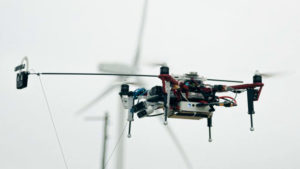Completely self-ruling robots that can investigate harmed wind homesteads have been created by Scots researchers.
In contrast to most automatons, they don’t require a human administrator and could end the requirement for experts to abseil down turbines to do fixes.
The multi-million pound venture is indicating how the bots can walk, jump, fly and even have an independent perspective.
They’re being created by Orca – the Offshore Robotics for Certification of Assets center point.
The center point charges itself as the biggest scholarly focus of its sort on the planet and is driven from Heriot-Watt and Edinburgh colleges through its Center for Robotics.
The consortium likewise includes Imperial College London, the colleges of Oxford and Liverpool, and in excess of 30 industry accomplices.
Together, they are delivering exceptional robots.

Dr Mirko Kovac and his associates in the ethereal mechanical autonomy research facility at Imperial College London have made another sort of flying automaton.
Elevated automatons are now utilized seaward to review hard-to-arrive at structures.
Yet, this one goes further: it can move to join itself to vertical surfaces and has an automated arm.
An automaton like this could travel to a breeze turbine, to examine it as well as to convey a sensor or even do a fix.
Furthermore, in light of the fact that it’s independent there’d be no one inland with a remote control.
It would mean a conclusion to the unsafe business of people wearing hard caps and bridles to dangle from a high turbine section over a hurling ocean.
In the mean time, ANYmal can go walkies.
This robot – which has the demeanor of a thick, electronic Rottweiler about it – gets about on four legs rather than wheels. It has been delivered by the organization ANYbotics and is now available.
Oxford’s Dynamics Robot Systems Group is utilizing ANYmal to grow new arranging and route procedures.
Head specialist at the Orca Hub, Prof David Lane of Heriot-Watt, says it shows new open doors in the vitality business.
“A ton of the seaward stages we take a shot at are little. The spaces are limited, and wheeled robots won’t have the option to arrange their way around the entire stage,” he says.
“So robots that creep, that have legs and can walk, they can go puts on the stage that different robots wouldn’t have the option to.”
Building trust
Orca’s accomplices are additionally growing seaward robots that can move on wheels, drift on water or sink underneath its surface.
Heriot-Watt were early pioneers in creating submersibles that can examine, fix and help decommission seaward structures.
Be that as it may, Orca’s distinct advantage lies in creating robots that are not remotely controlled however independent and settle on choices for themselves.
Utilizing computerized reasoning to make machines that can learn hands on methods fixes and reviews can be completed where radio sign don’t reach and control links won’t extend.
To the alleviation of many, there is as yet a level of human supervision.
Helen Hastie, educator of software engineering at Heriot-Watt and one of Orca’s specialized leads, says it is an issue of structure trust among human and machines.
“They have an independent component, which implies that they sense the earth and can settle on specific choices without anyone else’s input,” she says.
“In any case, what’s significant is straightforwardness, with the goal that the administrator comprehends what the robot is doing and why, and we’re attempting to persuade the robots to be reasonable so they can disclose their conduct to the administrator.”
‘Out of damage’s way’
The Orca Hub is a piece of the UK government’s £93m R&D subsidizing for apply autonomy and AI for outrageous conditions.
The seaward business is under consistent strain to turn out to be progressively proficient. This can be a code word for redundancies.
Prof Lane says it is anything but an issue of putting individuals out of work.
“Individuals simply do various occupations,” she says. “What it does it remove individuals from damage’s way.
“The robots will be seaward taking the necessary steps however there will even now be a lot of individuals back inland who will chip away at the information and really dealing with the robots.
“The robots don’t fix themselves.”
